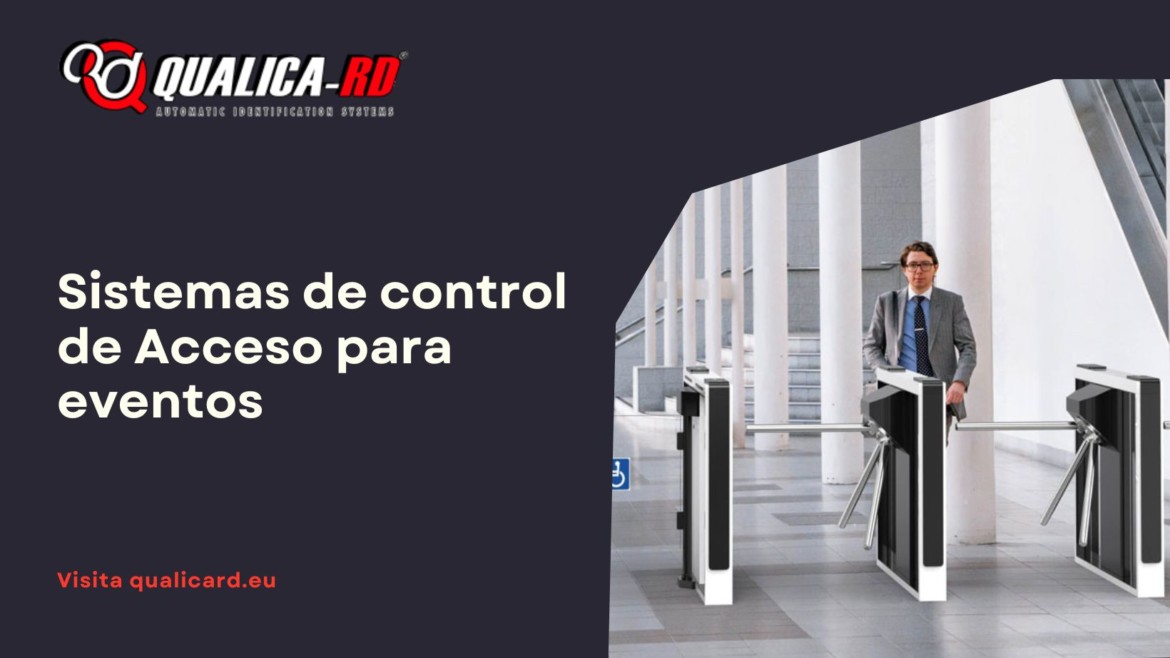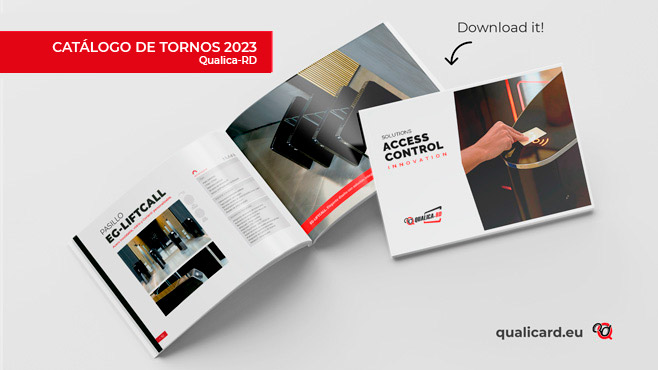The Revolution of Event Access Control Systems: Today, efficient management of the entry and exit of attendees at sporting events, concerts and conventions has taken a new direction thanks to innovative technology in access control systems. These solutions not only offer security and organization but also improve the user experience, marking a before and after in the events industry worldwide.
Introduction to Event Access Control
The digital era has completely transformed the way we organize and manage events, leading the industry to adopt new technologies to improve the experience of both organizers and attendees. Within this context, Event Access Control Systems have become an indispensable tool, not only for security reasons, but also for efficiency and the ability to provide valuable data on attendance and attendee behavior.
Access control at events, from massive concerts to conferences and sporting events, has evolved from traditional methods such as paper tickets to advanced technological solutions that include the use of QR codes, RFID wristbands, and mobile applications. These innovations offer faster and more secure access, reducing queues and improving the user experience. At the same time, they enable organizers to monitor attendance in real time and better manage event capacity.
In addition, the flexibility of modern access control systems makes it possible to tailor the experience of each event to its specific needs. Whether at sporting events, where careful entry control is crucial for attendee safety, or concerts, which require seamless management of large crowds, technology has opened up a world of possibilities to customize and enhance every aspect of event access.
What are Access Control Systems?
Access Control Systems represent an essential technological solution for the safe and efficient management of the entry and exit of attendees at various types of events. These technological tools not only facilitate capacity management, but also ensure that only authorized persons can access restricted areas, which is vital to maintain security and order at any event.
In their application, systems vary from proximity cards, QR codes, to more advanced solutions such as facial or biometric recognition, thus offering a wide range of options adapted to the specific needs of each event. The choice of the most appropriate access control system depends on several factors, including the size of the event, the level of security desired, and the experience you want to offer attendees.
Today, the use of these systems goes beyond the simple management of entrances and exits, incorporating functionalities that enrich the user experience, such as access to real-time information about the event, social interactions, and even integrated purchases within the system itself. This constant evolution in access control systems shows a trend towards the creation of increasingly interactive, secure and personalized events.
Importance of Access Control Today
Nowadays, access control has become an indispensable tool in the management of security and organization in both private and public spaces. Its importance lies not only in its ability to limit access to restricted areas, but also in its function as an element of flow control, thus ensuring a safe and orderly environment. This is especially relevant in a context where mass events and crowds present significant challenges in terms of security and logistics.
In addition, technological progress has allowed access control systems to evolve, offering increasingly innovative and effective solutions. From badge-based systems to biometric solutions and mobile applications, the variety of options available allows access control to be tailored to the specific needs of each situation. This demonstrates the flexibility and adaptability of these systems to the changes and demands of the modern world.
Implementing efficient access control systems not only improves security, but also raises the perception of professionalism and modernity of an organization or event. In a world where security is a priority, having a robust and reliable access control system has become a common expectation for attendees and participants. The importance of these systems, therefore, transcends their primary function, becoming a symbol of trust and commitment to the welfare of people.
Types of Event Access Control Systems
In the world of events, whatever their nature, security and organization are essential to ensure the experience of each attendee. This is where access control systems come into play, an essential tool that has evolved with technology to offer efficient solutions tailored to the needs of each event. From large concerts to professional conferences, the types of access control systems for events vary significantly, allowing you to select the most appropriate option for each situation.
Choosing the right access control system can make a substantial difference in managing the flow of people, ensuring not only security but also a better experience for attendees. The most common systems range from traditional methods of control using guest lists and identification wristbands to advanced technological solutions such as mobile applications and systems based on RFID or facial recognition.
Each type of system offers particular benefits. For example, RFID wristbands facilitate fast and secure entry, as well as providing additional options such as access control to VIP areas or integration with contactless payment systems. On the other hand, mobile applications not only allow access control but can also enhance the user experience by providing relevant information about the event in real time.
RFID Technology Based Systems
In the world of event management, the adoption of RFID (Radio Frequency Identification) based systems marks a turning point in the way we manage access control. These systems not only offer an efficient and secure solution for managing large crowds, but also expand the possibilities of interaction, offering a unique experience for both organizers and attendees.
The use of RFID technology at events enables fast ticket verification, significantly reducing queues and improving customer satisfaction. In addition, this system enables better data collection on attendees’ habits and preferences, allowing for better planning and customization of future events. Undoubtedly, RFID technology is redefining the gold standard for event access control systems.
In addition to improving the user experience, the implementation of RFID technology in access control opens doors to new forms of interaction and engagement with attendees, such as contactless payments, interaction with activation stations, and much more. Enhanced security and the ability to efficiently manage large volumes of people are just the tip of the iceberg of what these systems can offer today.
Biometric Access Control
The implementation of biometric access control is revolutionizing the way we manage entry and security at events. Integrating systems that recognize unique characteristics of individuals, such as fingerprints, facial recognition, or iris patterns, not only elevates the level of security, but also streamlines the flow of attendees, providing an unprecedented experience for both organizers and participants.
Biometrics, with its ability to provide fast and accurate identifications, is becoming the preferred solution over traditional methods of access control. This is because it significantly minimizes the risk of unauthorized entry, virtually eliminating the possibility of duplicate or counterfeit access credentials.
In addition, biometric access control can be seamlessly integrated with event management systems, further simplifying access logistics and providing real-time attendance statistics. This not only improves security, but also provides valuable data for decision making and customization of future events.
QR Code Access Systems and Mobile Apps
In the digital age we live in, QR Code access systems and Mobile Apps have revolutionized the way we manage event and meeting admissions. Their implementation not only facilitates fast and secure entry, but also contributes to a much smoother experience for both organizers and attendees. Thanks to these systems, it is possible to minimize queues and ensure more efficient entry verification.
QR codes, for example, allow for quick reading and identification of the ticket or digital invitation. The process is simple: the attendee receives his or her ticket in digital format, which includes a unique QR code. Upon arrival at the event, he only has to show his code, which is scanned with a special device or even a smartphone, allowing immediate access. This system not only streamlines the entry flow, but also increases security, reducing the chances of fraud or duplicate entries.
On the other hand, Mobile Applications specialized in events go a step further, offering additional functionalities such as the possibility of interacting with other attendees, accessing relevant event information in real time and even making in-app payments for services or products within the event. The integration of these applications with access control systems represents a significant advance in event management, providing a 360-degree experience to all participants.
Implementation of Access Control Systems
The implementation of access control systems in different environments, especially in events and venues with large crowds, is now more than ever a key part of managing security and operational efficiency. With the constant advancement of technology and the increasing need for robust and reliable systems, adopting an effective access control strategy becomes critical to the success of any event or facility.
Adopting these technologies not only improves the ability to manage and monitor the flow of people, but also allows for a more organized and satisfying experience for attendees. Implementing the right access control system can mean the difference between an event remembered for its fluidity and organization or one marked by chaos and complications.
In addition, implementing these systems provides an extra layer of security, ensuring that only authorized people can access certain areas. This is especially important at large events, where effective access control is not only a matter of order, but also of protection for both attendees and staff.
Therefore, understanding the specific needs of each event or venue and choosing an access control system that aligns with these, taking into account available technology and current trends, is critical. The right choice will not only facilitate better event management but also enhance security, thus contributing to the overall success and positive perception by participants.
Pre-implementation Considerations
Implementing at any event, building or company is not a task to be taken lightly. It requires detailed planning and a clear understanding of the objectives to be achieved. Before taking the step towards the implementation of these technologies, there are several prior considerations that must be taken into account to ensure the success of the project.
First, it is critical to conduct a thorough analysis of the specific security and control needs you want to address. This includes understanding the flow of people expected to be managed, identifying critical access points, and considering the nature of the events or activities taking place. It is at this point that the needs must be aligned with the capabilities of the different access control systems available on the market.
In addition, another key aspect is the evaluation of the existing infrastructure. In many cases, implementing a new access control system may require modifications to the physical structure of the facility or integration with existing electronic security systems. Therefore, close collaboration with technology providers and security experts is essential to design a solution that is not only effective, but also scalable for the future.
In summary, the adoption of access control systems represents a significant investment in the security and efficiency of any operation. However, to ensure that this investment returns the maximum possible value, it is critical to address these upfront considerations with the utmost detail and attention.
Steps to Successful Implementation
Before embarking on the implementation of access control systems for events or facilities, it is crucial to consider a number of aspects that will ensure the success and efficiency of the system. First, assessing the specific security and management needs of the event or venue is essential to selecting the most appropriate technology and type of system. It is important to ask: What level of security is required and what is the expected number of visitors or participants?
Secondly, the existing infrastructure plays a determining role in the choice of system. Organizers should consider whether infrastructure modifications or upgrades are required to make it compatible with the new access control system. Also, the available budget can mean the difference between opting for a more technologically advanced solution, such as biometrics or RFID-based systems, and a more traditional but equally effective one.
Finally, do not underestimate the importance of proper training of the personnel who will operate and manage the system. A well-educated team can take full advantage of the system’s capabilities, thus ensuring that security is maintained and a positive experience is provided for both organizers and attendees. Careful planning and consideration of these factors are essential to a successful implementation of access control systems.
Testing and Final Adjustments
The testing and final adjustments phase is crucial to ensure the effectiveness and efficiency of access control systems in any event or facility. This stage allows identifying and correcting any problems before its final implementation, thus ensuring security and fluidity in the access of attendees.
During testing, it is important to simulate different scenarios and situations that could occur during the actual event. This includes high flow of people, unauthorized access attempts, and interoperability with other systems such as ticketing or guest management. Meticulousness in this phase can prevent bugs and vulnerabilities that affect the user experience or compromise the security of the event.
Final adjustments, meanwhile, should focus on both optimizing system performance and improving the user experience. This could include, for example, adjusting the sensitivity of biometric readers or updating the interface of the mobile access application to make it more intuitive. The feedback obtained during pilot tests with real users becomes an invaluable tool for refining every detail of the system.
In conclusion, the more thorough and well-planned the tests and final adjustments are, the greater the security and satisfaction in access to events. The implementation of access control systems is an investment in peace of mind and professionalism, and as such, requires meticulous attention to the smallest details to ensure its success.
Benefits and Challenges
In today’s digital era, access control systems represent a fundamental pillar to ensure efficiency and security in various types of events. These systems not only offer innovative solutions to manage the flow of people, but also respond to emerging challenges in event management.
The implementation of advanced systems such as biometrics, QR codes, and mobile applications has revolutionized the way organizers and participants interact, offering an unprecedented experience. These technologies facilitate not only secure and fast access to the venue, but also real-time data management, enabling more agile and informed decision making.
In addition to improving security and efficiency, modern access control systems offer an opportunity to customize the attendee experience, adapting to their personal needs and preferences. This not only increases attendee satisfaction, but also fosters greater interaction and engagement during the event.
In short, the adoption of state-of-the-art access control systems is crucial to meet today’s challenges in event management, ensuring a safe, smooth and memorable experience for all involved. Continued innovation in this field promises to further raise the standard of what can be achieved, leading the way into the future of event management.
Advantages of Implementing an Access Control System
The implementation of an access control system in any environment, especially in high-traffic events or facilities, not only significantly improves security but also improves efficiency in the management of attendees and resources. These systems, which range from RFID technologies to biometric solutions and mobile applications, allow detailed management of who can and cannot access certain areas, at what times and under what conditions.
The advantages of implementing an access control system are many and varied. On the one hand, they offer an additional layer of security, preventing unauthorized access and enabling rapid action in case of emergencies. On the other hand, they optimize human and technical resources by automating processes that traditionally required manual management, such as ticket verification at large events.
In addition, these systems provide a smoother and more satisfactory experience for the user or attendee. The speed of registration and access to events minimizes queues and unnecessary waiting, significantly improving the perception of the event and the brand or organizing entity. The implementation of access control systems thus becomes not only a security measure, but also a valuable management and marketing strategy.
However, the choice of the right system must be carefully considered, taking into account the specific needs of the event or facility, as well as the existing infrastructure and the necessary investment. The challenges can be diverse, from integration with existing systems to staff training or user acceptance. Detailed planning and expert advice are key in the implementation process to ensure that potential advantages become tangible realities and long-term benefits.
Common Challenges and How to Overcome Them
In today’s world, where security and efficiency are paramount, facing the common challenges of implementing an access control system is an unavoidable task for many organizations. These systems not only provide an additional layer of security but also ensure efficient resource management. However, implementing these systems can come with both technical and organizational hurdles.
One of the main challenges lies in technological integration with existing systems. Often, older infrastructures are not ready to support new technologies, which can result in a fragmented or even incompatible implementation. The key to overcoming this challenge is to conduct a thorough analysis of needs and existing infrastructure, followed by meticulous planning that considers both current constraints and future needs.
Another aspect to consider is resistance to change on the part of end users. Switching to a new access control system can raise concerns about privacy and ease of use. To address this issue, it is crucial to foster a culture of transparency and education, ensuring that all stakeholders fully understand the benefits and operation of the new system. Adequate training and ongoing support are critical to facilitate a smooth transition.
In conclusion, while the challenges are significant, with proper planning, analysis and a user-centric approach, it is possible to overcome these obstacles and take full advantage of the benefits offered by access control systems to improve the security and efficiency of any organization.
Success Stories: Access Control at Sporting Events and Concerts
The implementation of access control systems at sporting events and concerts has transformed the way organizers and attendees experience these events. A notable success story is the use of RFID technology at large-scale music festivals, enabling fast and secure entry, as well as efficient management of the flow of people. In addition, the adoption of biometrics systems at high-profile sporting events has raised security standards, ensuring that only authorized attendees can access restricted areas.
These technological advances not only enhance the user experience but also provide organizers with valuable data on attendance and spectator behavior. The real-time tracking and analytics provided by these access control solutions empower data-driven decision making, facilitating the organization of future events. Consequently, the use of QR code access systems and mobile applications has proven to be instrumental in increasing customer satisfaction and strengthening event security.
Conclusion: The Future of Access Control in Events
The field of events has undergone significant changes thanks to the evolution of technology, with access control being one of the aspects that has undergone the most transformations. As we move into a more connected era, the future of event access control looks promising, offering not only enhanced security but also an optimized experience for both organizers and attendees. Advances in technologies such as biometrics, RFID and mobile apps have revolutionized the way people are managed in and out, ensuring smooth and seamless access.
Implementing efficient access control systems not only reduces security risks, but also allows for more accurate data collection, which can be used to enhance the event experience. This, in the long run, translates into more successful events and higher attendee satisfaction. However, we must not forget the challenges that these systems can present, such as the need for constant updating and managing data securely and privately. Despite these challenges, the future of event access control looks to be full of innovations that will continue to improve the security and experience of events in all aspects.
In conclusion, the future of event access control is bright and promises to transform events into more secure, efficient and personalized experiences. The key will be how event organizers embrace these technologies and adapt to the changes, ensuring not only the safety of attendees but also an unforgettable experience. As technology advances, so does our ability to create events that once seemed impossible, ushering in a new era in the event industry.






